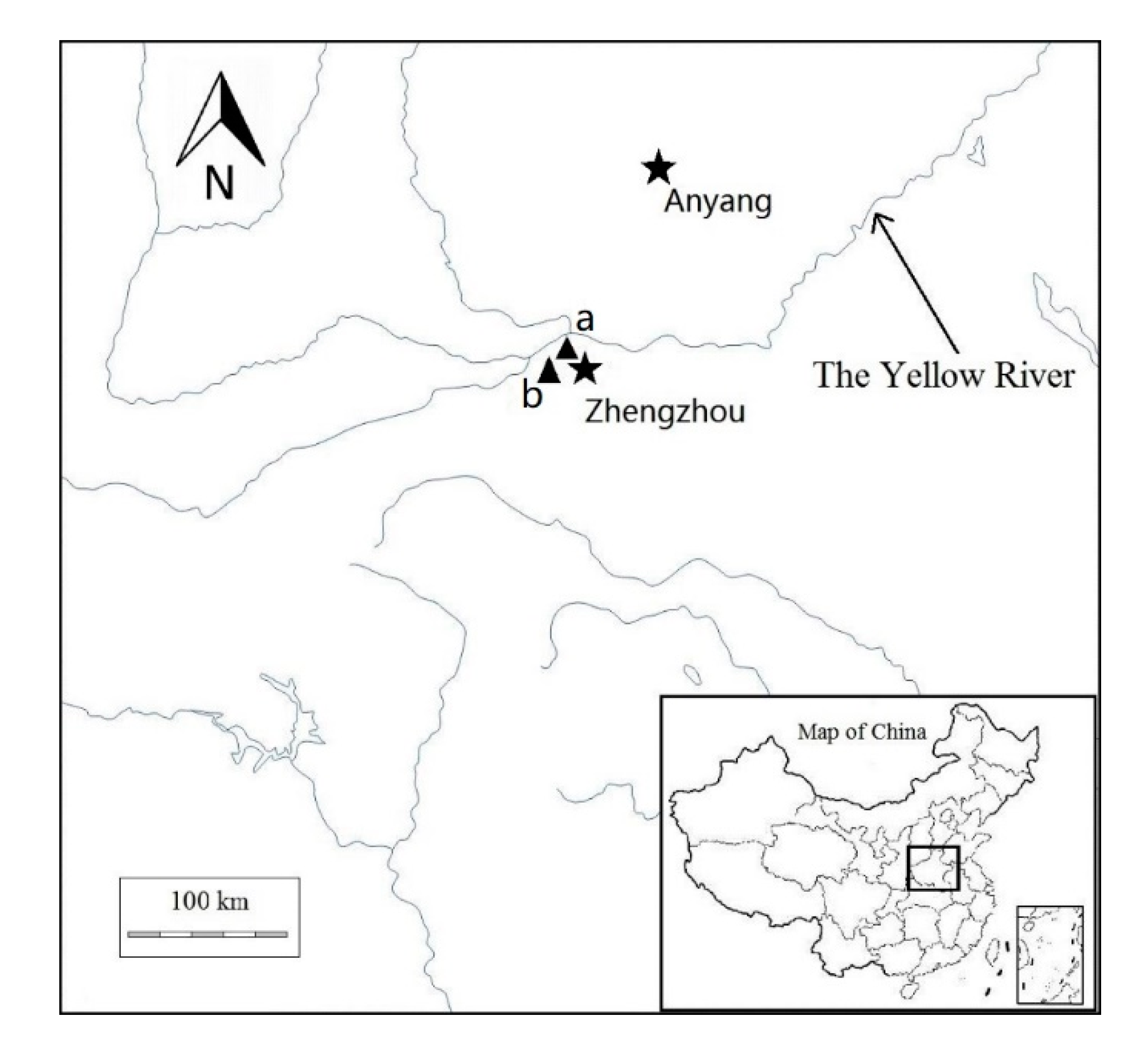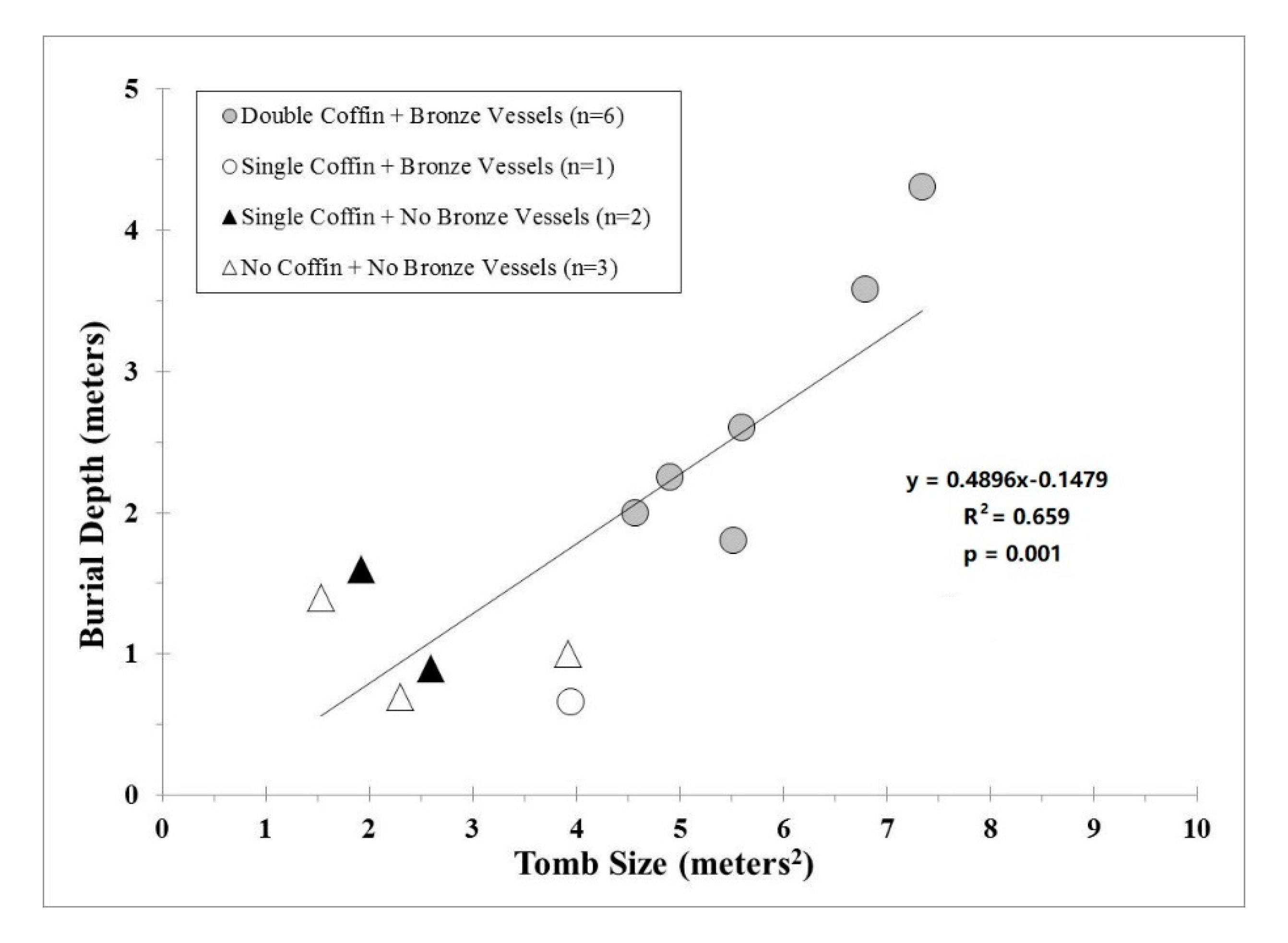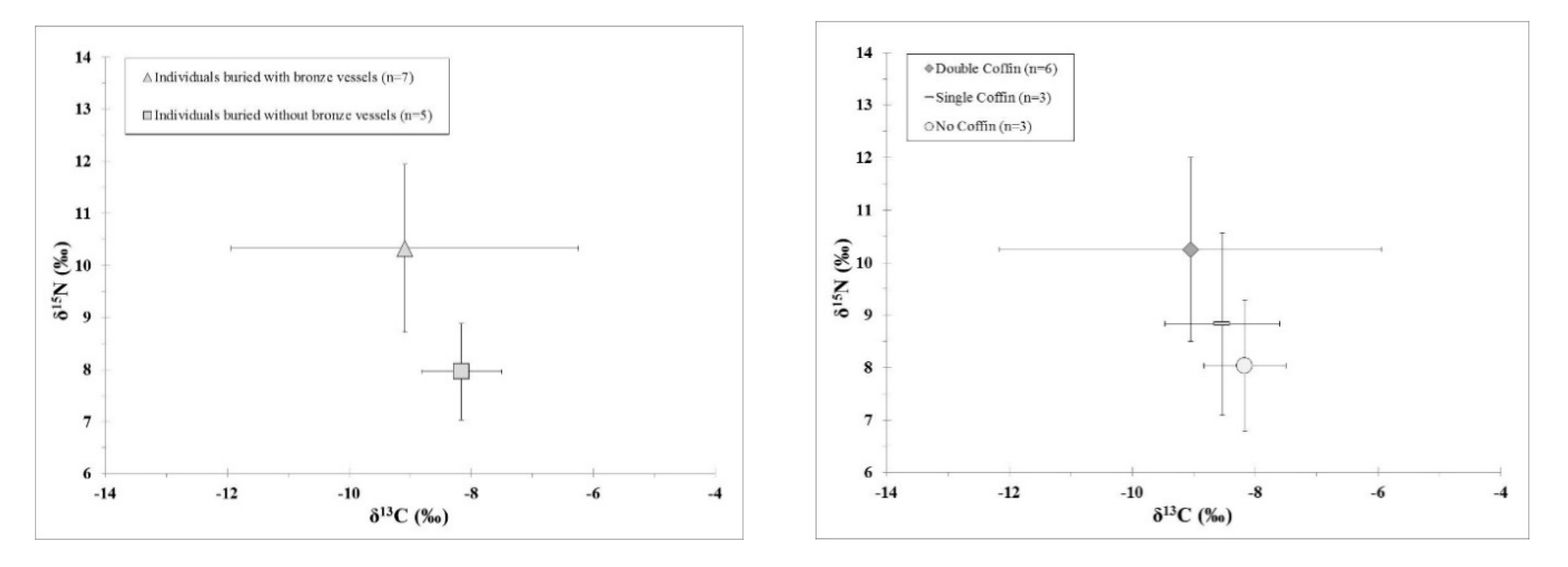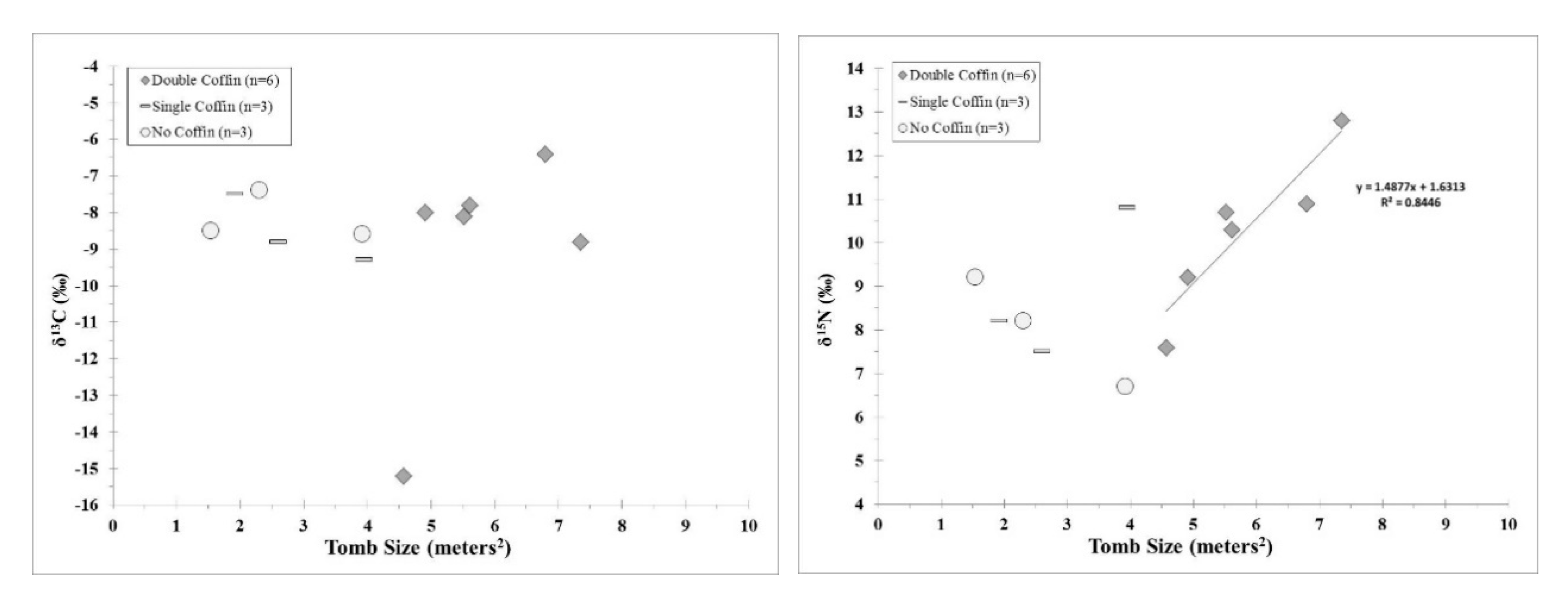Isotopic Results Reveal Possible Links between Diet and Social Status in Late Shang Dynasty (ca. 1250–1046 BC) Tombs at Xiaohucun, China
Abstract
1. Introduction
2. Background of Ritual Systems in Ancient China
3. Site of Xiaohucun, Henan Province, China
4. Materials and Methods
5. Results
5.1. Faunal Isotope Results
5.2. Human Isotope Results
6. Discussion
6.1. Burials and the Classification of Social Status during the Late Shang Dynasty
6.2. Diet and Social Status
7. Conclusions
Author Contributions
Funding
Acknowledgments
Conflicts of Interest
References
- Liu, L. The Chinese Neolithic: Trajectories to Early States (New Studies in Archaeology); Cambridge University Press: Cambridge, UK, 2007. [Google Scholar]
- Liu, L.; Chen, X.C. The Archaeology of China: From the Late Paleolithic to the Early Bronze Age; Cambridge University Press: Cambridge, UK, 2012. [Google Scholar]
- IA CASS. Chinese Archaeology: The Volume of Shang and Xia Dynasties; China Social Sciences Press: Beijing, China, 2003; pp. 98–101. (In Chinese) [Google Scholar]
- IA CASS. Chinese Archaeology: The Volume of Neolithic; China Social Sciences Press: Beijing, China, 2010; pp. 788–801. (In Chinese) [Google Scholar]
- Dai, S. Li Ji: Book of Rites; The North Literature and Art Publishing Houses: Harbin, China, 2013; p. 437. (In Chinese) [Google Scholar]
- Xun, K. Xunzi; Yan Shi Press: Beijing, China, 2011; p. 658. (In Chinese) [Google Scholar]
- Wang, W. The social structure of Zhou dynasty reflects by tomb system and comparisons with Shang dynasty. Sci. Chi. 2004, 3, 54–55. (In Chinese) [Google Scholar]
- Binford, L.R. Mortuary Practices: Their Study and Potential. Mem. Soc. Am. Archaeol. 1971, 25, 6–29. [Google Scholar] [CrossRef]
- Binford, L.R. Meaning, Inference, and the Material Record. In Ranking, Resource, and Exchange; Cambridge University Press: Cambridge, UK, 1982; pp. 160–163. [Google Scholar]
- O’Shea, J.M. Social Configurations and the Archaeological Study of Mortuary Practices: A Case Study. In The archaeology of Death; Chapman, R., Kinnes, I., Randsborg, K., Eds.; Cambridge University Press: Cambridge, UK, 1981; pp. 39–52. [Google Scholar]
- O’Shea, J.M. Mortuary Custom in Bronze Age of Southeastern Hungary, Diachronic and Synchronic Perspectives. In Regional Approaches to Mortuary Analysis: Interdisciplinary Contributions to Archaeology; Lane, A.B., Ed.; Springer: Berlin, Germany, 1995; pp. 125–145. [Google Scholar]
- Saxe, A.A. Social Dimensions of Mortuary Practices in a Mesolithic Population from Wadi Halfa, Sudan. Ph.D. Thesis, Department of Anthropology, University of Michigan, Ann Arbor, MA, USA, 1970. [Google Scholar]
- Van der Merwe, N.J.; Vogel, J.C. 13C content of human collagen as a measure of prehistoric diet in woodland North America. Nature 1978, 276, 815–816. [Google Scholar] [CrossRef] [PubMed]
- Schoeninger, M.J.; DeNiro, M.J. Nitrogen and carbon isotopic composition of bone collagen from marine and terrestrial animals. Geochim. Cosmochim. Acta. 1984, 48, 625–639. [Google Scholar] [CrossRef]
- Sealy, J.C.; van der Merwe, N.J.; Thorp, J.A.L.; Lanham, J.L. Nitrogen isotopic ecology in southern Africa: Implications for environmental and dietary tracing. Geochim. Cosmochim. Acta. 1987, 51, 2707–2717. [Google Scholar] [CrossRef]
- Katzenberg, M.A.; Weber, A. Stable isotope ecology and palaeodiet in the Lake Baikal region of Siberia. J. Archaeol. Sci. 1999, 26, 651–659. [Google Scholar] [CrossRef]
- Valentin, F.; Bocherens, H.; Gratuze, B.; Sand, C. Dietary patterns during the late prehistoric/historic period in Cikobia Island (Fiji): Insights from stable isotopes and dental pathologies. J. Archaeol. Sci. 2006, 33, 1396–1410. [Google Scholar] [CrossRef]
- Müldner, G.; Richards, M.P. Stable isotope evidence for 1500 years of human diet at the city of York, UK. Am. J. Phys. Anthropol. 2007, 133, 682–697. [Google Scholar] [CrossRef]
- Choy, K.; Jean, O.R.; Fuller, B.T.; Richards, M.P. Isotopic evidence of dietary variations and weaning practices in the Gaya cemetery at Yeanri, Gimhae, South Korea. Am. J. Phys. Anthropol. 2010, 142, 74–84. [Google Scholar] [CrossRef]
- Bourbou, C.; Fuller, B.T.; Garvie-Lok, S.J.; Richards, M.P. Reconstructing the diets of Greek Byzantine populations (6th–15th centuries AD) using carbon and nitrogen stable isotope ratios. Am. J. Phys. Anthropol. 2011, 146, 569–581. [Google Scholar] [CrossRef]
- Commendador, A.S.; Dudgeon, J.V.; Finney, B.P.; Fuller, B.T.; Esh, K.S. Stable isotope (δ13C and δ15N) perspective on human diet on Rapa Nui (Easter Island) c.a. 1400-1900 AD. Am. J. Phys. Anthropol. 2013, 152, 173–185. [Google Scholar] [PubMed]
- Cui, Y.; Song, L.; Wei, D.; Pang, Y.; Wang, N.; Ning, C.; Li, C.; Feng, B.; Tang, W.; Li, H.; et al. Identification of kinship and occupant status in Mongolian noble burials of the Yuan Dynasty through a multidisciplinary approach. Philos. Trans. R. Soc. Lond. B. Biol. Sci. 2015, 370, 20130378. [Google Scholar] [CrossRef] [PubMed]
- Ma, M.M.; Dong, G.H.; Jia, X.; Wang, H.; Cui, Y.F.; Chen, F.H. Dietary shift after 3600 cal yr BP and its influencing factors in northwestern China: Evidence from stable isotopes. Quat. Sci. Rev. 2016, 145, 57–70. [Google Scholar] [CrossRef]
- Chen, X.L.; Fang, Y.M.; Hu, Y.W.; Hou, Y.F.; Lu, P.; Yuan, J.; Song, G.D.; Fuller, B.T.; Richards, M.P. Isotopic Reconstruction of the Late Longshan Period (ca.4200–3900BP) Dietary Complexity before the Onset of State-Level Societies at the Wadian Site. Int. J. Osteoarchaeol. 2016, 26, 808–817. [Google Scholar] [CrossRef]
- Stenhouse, M.J.; Baxter, M.S. The uptake of bomb 14C in humans, in radiocarbon dating. In Radiocarbon Dating: Proceedings of the Ninth International Conference, Los Angeles and La Jolla; Berger, R., Suess, H.E., Eds.; University of California Press: Berkeley, CA, USA, 1979; pp. 324–341. [Google Scholar]
- Hedges, R.E.M.; Clement, J.G.; Thomas, C.D.L.; O’Connell, T.C. Collagen turnover in the adult femoral mid-shaft: Modeled from anthropogenic radiocarbon tracer measurements. Am. J. Phys. Anthropol. 2007, 133, 808–816. [Google Scholar] [CrossRef]
- Schwarcz, H.P.; Schoeninger, M.J. Stable isotopic analyses in human nutritional ecology. Yearb. Phys. Anthropol. 1991, 34, 283–321. [Google Scholar] [CrossRef]
- Pechenkina, E.A.; Ambrose, S.H.; Ma, X.; Benfer, J.R.A. Reconstructing northern Chinese Neolithic subsistence practices by isotopic analysis. J. Archaeol. Sci. 2005, 32, 1176–1189. [Google Scholar] [CrossRef]
- Hu, Y.; Wang, S.; Luan, F.; Wang, C.; Richards, M.P. Stable isotope analysis of humans from Xiaojingshan site: Implications for understanding the origin of millet agriculture in China. J. Archaeol. Sci. 2008, 35, 2960–2965. [Google Scholar] [CrossRef]
- Barton, L.; Newsome, S.D.; Chen, F.H.; Wang, H.; Guilderson, T.P.; Bettinger, R.L. Agricultural origins and the isotopic identity of domestication in northern China. Proc. Natl. Acad. Sci. USA 2009, 106, 5523–5528. [Google Scholar] [CrossRef]
- Fu, Q.M.; Jin, S.A.; Hu, Y.W.; Ma, Z.; Pan, J.C.; Wang, C.S. Agricultural development and human diets in Gouwan site, Xichuan, Henan. Chin. Sci. Bull. 2010, 55, 614–620. [Google Scholar] [CrossRef]
- Atahan, P.; Dodson, J.; Li, X.; Zhou, X.; Hu, S.; Bertuch, F.; Sun, N. Subsistence and the isotopic signature of herding in the Bronze Age Hexi Corridor, NW Gansu, China. J. Archaeol. Sci. 2011, 38, 1747–1753. [Google Scholar] [CrossRef]
- Lanehart, R.E.; Tykot, R.H.; Underhill, A.P.; Luan, F.; Yu, H.; Fang, H.; Feinman, G.; Nicholas, L. Dietary adaptation during the Longshan period in China: Stable isotope analyses at Liangchengzhen (southeastern Shandong). J. Archaeol. Sci. 2011, 38, 2171–2181. [Google Scholar] [CrossRef]
- Liu, X.; Jones, M.K.; Zhao, Z.; Liu, G.; O’Connell, T.C. The earliest evidence of millet as a staple crop: New light on neolithic foodways in North China. Am. J. Phys. Anthropol. 2012, 149, 283–290. [Google Scholar] [CrossRef] [PubMed]
- Atahan, P.; Dodson, J.; Li, X.; Zhou, X.; Chen, L.; Barry, L.; Bertuch, F. Temporal trends in millet consumption in northern China. J. Archaeol. Sci. 2014, 50, 171–177. [Google Scholar] [CrossRef]
- Hu, Y.W.; Luan, F.S.; Wang, C.S.; Richards, M.P. Preliminary attempt to distinguish the domesticated pigs from wild boars by the methods of carbon and nitrogen stable isotope analysis. Sci. China. Earth. Sci. 2009, 52, 85–92. [Google Scholar] [CrossRef]
- Chen, X.L.; Yuan, J.; Hu, Y.W.; He, N.; Wang, C.S. Animal feeding practice at Taosi site. Archaeology 2012, 9, 75–82. (In Chinese) [Google Scholar]
- Chen, X.L.; Hu, S.M.; Hu, Y.W.; Ma, R.Y.; Wang, W.L.; Lu, P.; Wang, C.S. Raising practices of Neolithic livestock evidenced by stable isotope analysis in the Wei River valley, North China. Int. J. Osteoarchaeol. 2014, 26, 42–52. [Google Scholar] [CrossRef]
- Hou, L.L.; Hu, Y.W.; Zhao, X.P.; Li, S.T.; Wei, D.; Hou, Y.F.; Hu, B.H.; Lv, P.; Li, T.; Song, G.D.; et al. Human subsistence strategy at Liuzhuang site, Henan, China during the proto-Shang culture (∼2000–1600 BC) by stable isotopic analysis. J. Archaeol. Sci. 2013, 40, 2344–2351. [Google Scholar] [CrossRef]
- Bocherens, H.; Drucker, D. Trophic level isotopic enrichment of carbon and nitrogen in bone collagen: Case studies from recent and ancient terrestrial ecosystems. Int. J. Osteoarchaeol. 2003, 13, 46–53. [Google Scholar] [CrossRef]
- Reitsema, L.J. Beyond diet reconstruction: Stable isotope applications to human physiology, health, and nutrition. Am. J. Hum. Biol. 2013, 25, 445–456. [Google Scholar] [CrossRef]
- Bol, R.; Pflieger, C. Stable isotope (13C, 15N and 34S) analysis of the hair of modern humans and their domestic animals. Rapid. Commun. Mass. Spectrom. 2002, 16, 2195–2200. [Google Scholar] [CrossRef]
- Petzke, K.J.; Boeing, H.; Metges, C.C. Choice of dietary protein of vegetarians and omnivores is reflected in their hair protein C-13 and N-15 abundance. Rapid. Commun. Mass. Spectrom. 2005, 19, 1392–1400. [Google Scholar] [CrossRef]
- Katzenberg, M.A. Stable isotope analysis: A tool for studying past diet, demography, and life history. In Biological Anthropology of the Human Skeleton; Katzenberg, M.A., Saunders, S.R., Eds.; Wiley-Liss: New York, NY, USA, 2000; pp. 305–327. [Google Scholar]
- Ambrose, S.H.; Krigbaum, J. Bone chemistry and bioarchaeology. J. Anthropol. Archaeol. 2003, 22, 193–199. [Google Scholar] [CrossRef]
- Lee-Thorp, J.A. On isotopes and old bones. Archaeometry 2008, 50, 925–950. [Google Scholar] [CrossRef]
- Richards, M.P.; Hedges, R.E.M.; Molleson, T.I.; Vogel, J.C. Stable isotope analysis reveals variations in human diet at the Poundbury Camp cemetery site. J. Archaeol. Sci. 1998, 25, 1247–1252. [Google Scholar] [CrossRef]
- Ambrose, S.H.; Buikstra, J.; Krueger, H.W. Status and gender differences in diet at Mound 72, Cahokia, revealed by isotopic analysis of bone. J. Anthropol. Archaeol. 2003, 22, 217–226. [Google Scholar] [CrossRef]
- Kjellström, A.; Jan Storå, J.; Göran Possnert, G.; Linderholm, A. Dietary patterns and social structures in Medieval Sigtuna, Sweden, as reflected in stable isotope values in human skeletal remains. J. Archaeol. Sci. 2009, 36, 2689–2699. [Google Scholar] [CrossRef]
- Yoder, C. Let them eat cake? Status-based differences in diet in medieval Denmark. J. Archaeol. Sci. 2012, 39, 1183–1193. [Google Scholar] [CrossRef]
- Quintelier, K.; Ervynck, A.; Müldner, G.; Van Neer, W.; Richards, M.P.; Fuller, B.T. Isotopic Examination of Links Between Diet, Social Differentiation, and DISH at the Post-Medieval Carmelite Friary of Aalst, Belgium. Am. J. Phys. Anthropol. 2014, 153, 203–213. [Google Scholar] [CrossRef]
- Dong, Y.; Morgan, C.; Chinenov, Y.; Zhou, L.G.; Fang, W.Q.; Ma, X.L.; Pechenkina, K. Shifting diets and the rise of male-biased inequality on the Central Plains of China during Eastern Zhou. Proc. Natl. Acad. Sci. USA 2017, 114, 932–937. [Google Scholar] [CrossRef]
- Twiss, K. The archaeology of food and social diversity. J. Archaeol. Res. 2012, 20, 357–395. [Google Scholar] [CrossRef]
- Henan Provincial Institute of Cultural Relics and Archaeology. Xipo Cemetery, Lingbao; Cultural Relics Press: Beijing, China, 2010. (In Chinese) [Google Scholar]
- Ling, X.; Chen, L.; Tian, Y.Q.; Li, Y.; Zhao, C.C.; Hu, Y.W. Carbon and Nitrogen Stable Isotopic Analysis on Human Bones from the Qin Tomb of Sun jianantou Site, Fengxiang, Shaanxi Province. Acta Anthropologica Sinica 2010, 29, 54–61. (In Chinese) [Google Scholar]
- Zhang, X.L.; Qiu, S.H.; Zhong, J.; Liang, Z.H. The carbon, nitrogen stable isotope analysis of human bone from Qianzhangda Cemetery. Archaeology 2012, 9, 83–90. (In Chinese) [Google Scholar]
- Zhang, X.L.; Qiu, S.H.; Zhang, J.; Guo, W. The carbon and nitrogen stable isotope analysis of human bones from Duogang cemetery, Xinjiang. South. Antiq. 2014, 3, 79–91. (In Chinese) [Google Scholar]
- Wang, Y.; Nan, P.H.; Wang, X.Y.; Wei, D.; Hu, Y.W.; Wang, C.S. Dietary Differences in Humans with Similar Social Hierarchies: Example from the Niedian Site, Shanxi. Acta Anthropologica. Sinica 2014, 33, 82–89. (In Chinese) [Google Scholar]
- Li, C. Anyang; University of Washington Press: Seattle, WA, USA, 1978. [Google Scholar]
- Chang, K.C. Shang Civilization; Yale University Press: New Haven, CT, USA, 1980. [Google Scholar]
- Loewe, M.; Shaughnessy, E.L. The Cambridge History of Ancient China: From the Origins of Civilization to 221 B.C.; Cambridge University Press: Cambridge, UK, 1999. [Google Scholar]
- Thorp, R.L. China in the Early Bronze Age: Shang Civilization; University of Pennsylvania Press: Philadelphia, PA, USA, 2005; p. 320. [Google Scholar]
- Zhu, Y. The Origin, Migration and Development of Shang Clan; The Commercial Press: Beijing, China, 2007. (In Chinese) [Google Scholar]
- Zhang, G.Z. Shang Civilization; SDX Joint Publishing Company: Beijing, China, 2013. (In Chinese) [Google Scholar]
- Henan Provincial Institute of Cultural Relics and Archaeology. Unearthing bulletin for late Shang remains of Guandimiao ruins in Xingyang City of Henan Province. Archaeology 2008, 7, 32–46. (In Chinese) [Google Scholar]
- Song, Z.H. The Social Life History of Xia and Shang Dynasty; China Social Sciences Press: Beijing, China, 1994. (In Chinese) [Google Scholar]
- Song, Z.H. China Diet History: Xia and Shang Dynasty; Huaxia Press: Beijing, China, 1999. (In Chinese) [Google Scholar]
- Song, Z.H. Social Lives and Rituals in Shang Dynasty; China Social Sciences Press: Beijing, China, 2010. (In Chinese) [Google Scholar]
- Wang, X. Dietetic rules and regulations research in Zhouli. Master’s Thesis, Yangzhou University, Yangzhou, China, 2007. (In Chinese). [Google Scholar]
- Wang, Y.X.; Xu, Y.H. Countries and Society in Shang Dynasty; China Social Sciences Press: Beijing, China, 2011. (In Chinese) [Google Scholar]
- Tang, J.G. The Social Organization of Late Shang China: A Mortuary Perspective. Ph.D. Thesis, University of London, London, UK, 2004. [Google Scholar]
- Yu, W.C.; Gao, M. The study of the system with the tripod at Zhou dynasty. J. Peking Univ. Philosophy Soc. Sci. 1978, 2, 84–97. (In Chinese) [Google Scholar]
- Reinhart, K. Ritual feasting and empowerment at Yanshi Shangcheng. J. Anthropol. Archaeol. 2015, 39, 76–109. [Google Scholar] [CrossRef]
- Qing, L. Type value and grave value: An introduction to a quantifying method in tomb research. Huaxia Archaeol. 2007, 3, 133–137. (In Chinese) [Google Scholar]
- Wu, F. The research of funeral furniture of Shang Dynasty. Master’s Thesis, Zhengzhou University, Zhengzhou, China, 2012. (In Chinese). [Google Scholar]
- Jia, L.M.; Zeng, X.; Liang, F.; Yu, H.W. The Xiaohucun late Shang noble cemetery of Xiangyang city, Hennan. In Archaeological Society of China, Important Archaeology Discoveries in China of 2006; Cultural Relics Press: Beijing, China, 2007. (In Chinese) [Google Scholar]
- Lee, G.; Crawford, G.W.; Liu, L.; Chen, X. Plants and people from the early Neolithic to Shang periods in North China. Proc. Natl. Acad. Sci. USA 2007, 104, 1087–1092. [Google Scholar] [CrossRef]
- Qiu, S.H.; Zhong, J.; Zhao, X.P.; Sun, F.X.; Cheng, L.Q.; Guo, Y.Q.; Li, X.W.; Ma, X.L. Studies on Diet of the Ancient People of the Yangshao Cultural Sites in the Central Plains. Acta Anthropol. Sin. 2010, 29, 197–207. (In Chinese) [Google Scholar]
- IA CASS. Science for Archaeology: The Third Volume; Science Press: Beijing, China, 2011; pp. 1–35. (In Chinese) [Google Scholar]
- Liu, X.; Lightfoot, E.; O’Connell, T.C.; Wang, H.; Li, S.; Zhou, L.; Hu, Y.; Motuzaite-Matuzeviciute, G.; Jones, M.K. From necessity to choice: Dietary revolutions in west China in the second millennium BC. World Archaeol. 2014, 46, 661–680. [Google Scholar] [CrossRef]
- Jia, L.M.; Wang, W.B.; Lu, H.W.; Liang, F.W.; Zeng, X.M. Archaeological Excavation of Xiaohucun village cemetery in Xingyang, Henan Province. Huaxia Archaeol. 2015, 1, 3–25. (In Chinese) [Google Scholar]
- Zhu, H. Physical Anthropology; Higher Education Press: Beijing, China, 2004. (In Chinese) [Google Scholar]
- Richards, M.P.; Hedges, R.E.M. Stable isotope evidence for similarities in the types of marine foods used by Late Mesolithic humans at sites along the Atlantic coast of Europe. J. Archaeol. Sci. 1999, 26, 717–722. [Google Scholar] [CrossRef]
- DeNiro, M.J. Postmortem preservation and alteration of in vivo bone collagen isotope ratios in relation to palaeodietary reconstruction. Nature 1985, 317, 806–809. [Google Scholar] [CrossRef]
- Zhang, X.L.; Wang, J.X.; Xian, Z.Q.; Qiu, S.H. Studies on ancient human diet. Archaeology 2003, 2, 62–75. (In Chinese) [Google Scholar]
- Dai, L.; Li, Z.; Zhao, C.; Yuan, J.; Hou, L.; Wang, C.; Fuller, B.T.; Hu, Y. An isotopic perspective on animal husbandry at the Xinzhai site during the initial stages of the legendary Xia Dynasty (2070—1600 BC). Int. J. Osteoarchaeol. 2015. [Google Scholar] [CrossRef]
- IA CASS. Science for Archaeology: The Second Volume; Science Press: Beijing, China, 2007; pp. 1–34. (In Chinese) [Google Scholar]
- Xu, Z.Y.; Chang, P.Y. Zhou Li: Translation and Annotation; Zhonghua Book Company: Shanghai, China, 2014. (In Chinese) [Google Scholar]
- Liu, S.C. Chunqiu Gongyang Zhuan: Translation and Annotation; Zhonghua Book Company: Shanghai, China, 2011. (In Chinese) [Google Scholar]






| Status | Diet | Sacrifice | Travel | Burial | ||||
|---|---|---|---|---|---|---|---|---|
| Tableware and Courses per Meal | Meat in Diet | Bronze Vessels (Ding) in Ritual Activities | Carriage Number | Horse per Carriage | Coffin Number | Coffin Material | Ding + Gui Combination | |
| Emperor | 26 | Yes | 7 | NA | 6 | 7 | N/A | 9 & 8 |
| Prince | 12–16 | Yes | 5 | 7 | 4 | 5 | Pine | 7 & 6 |
| Senior Nobility | 8 | Yes | 4 | 5 | 3 | 3 | Cypress | 5 & 4 |
| Junior Nobility | 6 | Yes | 1 | 3 | 2 | 2 | Miscellaneous | 3 & 2 |
| Common People | 3–6 | Only older people | N/A | N/A | 1 | N/A | N/A | N/A |
| Lab ID | Location | Sex | Age | Open Size (m2) | Depth (m) | Coffin Type | # Grave Goods | Bronze Vessels | # Bronze Vessels | # Jade & other Objects | δ13C (‰) | δ15N (‰) | %C | %N | C:N |
|---|---|---|---|---|---|---|---|---|---|---|---|---|---|---|---|
| 1 | M8 | Male | 45–50 | 7.35 | 4.30 | double | 6 | yes | 6 | - | −8.8 | 12.8 | 29.9 | 11.5 | 3.0 |
| 2 | M24 | Male | 55 ± | 5.52 | 1.80 | double | 8 | yes | 7 | 1 | −8.1 | 10.7 | 38.6 | 14.0 | 3.2 |
| 3 | M27 | ? | 55 ± | 5.61 | 2.60 | double | 8 | yes | 3 | 5 | −7.8 | 10.3 | 41.0 | 14.9 | 3.2 |
| 4 | M30 | ? | ? | 4.57 | 2.00 | double | 7 | yes | 6 | 1 | −15.2 | 7.6 | 42.1 | 15.3 | 3.2 |
| 5 | M39 | ? | 40-45 | 3.92 | 1.00 | none | - | no | - | - | −8.6 | 6.7 | 40.2 | 14.9 | 3.1 |
| 6 | M46 | ? | 35 ± | 2.60 | 0.90 | single | - | no | - | - | −8.8 | 7.5 | 39.7 | 14.4 | 3.2 |
| 7 | M47 | ? | 25–30 | 1.92 | 1.60 | single | - | no | - | - | −7.5 | 8.2 | 38.4 | 14.1 | 3.2 |
| 8 | M52 | ? | ? | 6.80 | 3.58 | double | 11 | yes | 5 | 4 (1 cowrie shell & 1 wooden object) | −6.4 | 10.9 | 41.4 | 15.2 | 3.2 |
| 9 | M89 | ? | 50–55 | 2.30 | 0.70 | none | 1 | no | - | 1 | −7.4 | 8.2 | 41.2 | 15.2 | 3.2 |
| 10 | M90 | Male | 40–45 | 3.95 | 0.66 | single | 4 | yes | 2 | 1 (1 cowrie shell) | −9.3 | 10.8 | 39.6 | 14.7 | 3.2 |
| 11 | M105 | Male | ? | 4.91 | 2.25 | double | 5 | yes | 4 | 1 | −8.0 | 9.2 | 40.0 | 14.8 | 3.1 |
| 12 | M116 | Female | 45 ± | 1.54 | 1.40 | none | 1 | no | - | (1 cowrie shell) | −8.5 | 9.2 | 37.5 | 13.5 | 3.2 |
| Lab ID | Location | Species | δ13C (‰) | δ15N (‰) | %C | %N | C:N |
|---|---|---|---|---|---|---|---|
| a 1 | H28 | Pig (Sus scrofa domestica) | −8.2 | 7.8 | 35.1 | 13.0 | 3.2 |
| a 2 | H26 | Pig (Sus scrofa domestica) | −9.9 | 8.6 | 31.6 | 12.0 | 3.1 |
| a 3 | H26 | Deer (Cervus nippon) | −20.5 | 4.9 | 36.2 | 13.0 | 3.2 |
| a 4 | H741 | Pig (Sus scrofa domestica) | −6.7 | 6.6 | 41.8 | 15.0 | 3.2 |
| a 5 | H932 | Pig (Sus scrofa domestica) | −9.3 | 7.6 | 41.0 | 14.8 | 3.2 |
| a 6 | H932 | Dog (Canis lupus familiaris) | −7.6 | 8.6 | 37.3 | 13.7 | 3.2 |
| a 7 | H1309 | Cattle (Bos primigenius taurus) | −9.0 | 5.7 | 41.9 | 15.2 | 3.2 |
| a 8 | H1250 | Pig (Sus scrofa domestica) | −11.6 | 8.8 | 22.2 | 9.0 | 2.9 |
| a 9 | H1251 | Deer (Cervus nippon) | −15.0 | 7.6 | 40.0 | 14.3 | 3.3 |
| a 10 | J20 | Sheep/Goat (Caprinae) | −10.7 | 7.5 | 39.8 | 14.3 | 3.2 |
| a 11 | G7 | Dog (Canis lupus familiaris) | −7.5 | 7.6 | 37.4 | 13.8 | 3.2 |
| Type | Sub-Type | Tomb Passage | Size (m2) | Inner & Outer Coffins | Grave Goods | Human Sacrifice | Owner Status |
|---|---|---|---|---|---|---|---|
| A | a | 4 | >100 | always | abundant | always | Emperor |
| b | 2 | >20 | always | abundant | always | Prince | |
| c | 1 | 20–70 | always | abundant | always | Prince or senior nobility | |
| B | a | 0 | >10 | always | abundant | mostly | Prince or senior nobility |
| b | 0 | 3–10 | mostly | ordinary | rarely | Junior nobility | |
| c | 0 | <3 | rarely | little or absence | absence | Common people | |
| C | a | 0 | N/A | absence | absence | absence | Unprivileged people |
© 2020 by the authors. Licensee MDPI, Basel, Switzerland. This article is an open access article distributed under the terms and conditions of the Creative Commons Attribution (CC BY) license (http://creativecommons.org/licenses/by/4.0/).
Share and Cite
Wang, N.; Jia, L.; Si, Y.; Jia, X. Isotopic Results Reveal Possible Links between Diet and Social Status in Late Shang Dynasty (ca. 1250–1046 BC) Tombs at Xiaohucun, China. Atmosphere 2020, 11, 451. https://doi.org/10.3390/atmos11050451
Wang N, Jia L, Si Y, Jia X. Isotopic Results Reveal Possible Links between Diet and Social Status in Late Shang Dynasty (ca. 1250–1046 BC) Tombs at Xiaohucun, China. Atmosphere. 2020; 11(5):451. https://doi.org/10.3390/atmos11050451
Chicago/Turabian StyleWang, Ning, Lianmin Jia, Yi Si, and Xin Jia. 2020. "Isotopic Results Reveal Possible Links between Diet and Social Status in Late Shang Dynasty (ca. 1250–1046 BC) Tombs at Xiaohucun, China" Atmosphere 11, no. 5: 451. https://doi.org/10.3390/atmos11050451
APA StyleWang, N., Jia, L., Si, Y., & Jia, X. (2020). Isotopic Results Reveal Possible Links between Diet and Social Status in Late Shang Dynasty (ca. 1250–1046 BC) Tombs at Xiaohucun, China. Atmosphere, 11(5), 451. https://doi.org/10.3390/atmos11050451





